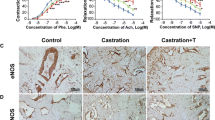Abstract
Objectives The influence of testosterone on the prostate and corpus cavernosum have been studied extensively. However, the influence of testosterone on the lower urinary tract (bladder and urethra) have not been investigated to any great extent. The aim of this study was to determine whether androgen deprivation alters lower urinary tract metabolism. Methods A total of 16 rabbits were divided into four groups of four rabbits each. Each rabbit in groups 1–3 underwent surgical bilateral castration for duration of 1, 2 , and 4 weeks, and group 4 underwent sham operations. Sections of bladder body and base wall and mucosa, urethra and corpora were isolated, frozen, and stored under liquid nitrogen. The activities of citrate synthase-thapsigargin sensitive Ca2+ ATPase (Sarco/Endoplasmic Reticulum Ca2+ ATPase [SERCA]), and choline acetyl-transferase were examined as markers for mitochondrial function, sarcoplasmic reticular calcium storage and release, and cholinergic nerve function, respectively. Results The activity of SR function indicator, Ca2+ ATPase was significantly higher in the control corpora than in the control bladder or urethra. Castration resulted in decreased activity in the mitochondria specific enzyme, citrate synthase, the activity of which was greatest in the urethra and lowest in the corpora. Cholinergic nerve density indicator, choline acetyl-transferase activity was greatest in the bladder body and lowest in the urethra. Conclusions Our data indicate that (1) significant differences exist in the activities of all three enzymes in the various organs associated with the lower urinary tract; and (2) that castration results in significant alterations in the activities of all three enzymes in the bladder body, base, urethra, and corpora.



Similar content being viewed by others
References
Buttyan R, Chen MW, Levin RM (1997) Animal models of bladder outlet obstruction and molecular insights into the basis for the development of bladder dysfunction. Eur Urol 32(Suppl 1):32–39
Mostwin JL, Karim OM, van Koeveringe G, Brooks EL (1991) The guinea pig as a model of gradual urethral obstruction. J Urol 145:854–858
Levin RM, Chichester P, Hass MA, Gosling JA, Buttyan R (2002) Obstructive bladder dysfunction: Morphological, biochemical, and molecular changes. Eur Urol Suppl 1:14–20
Salmi S, Santti R, Gustafsson JA, Makela S (2001) Co-localization of androgen receptor with estrogen receptor beta in the lower urinary tract of the male rat. J Urol 166:674–677
Haugaard N, Potter L, Wein AJ, Levin RM (1992) Effect of partial obstruction of the rabbit urinary bladder on malate dehydrogenase and citrate synthase activity. J Urol 147:1391–1393
Levin RM, Nicholas TJ, Snitkoff GG, Mandell J, Russell D, Wilbur HJ, Mogavero LJ (1997) Subcellular distribution of SERCA and calcium activated ATPase in rabbit and human urinary bladder smooth muscle. Pharmacology 55:136–143
Levin RM, Saito M, Wein AJ, Packard D, Cohen A, Haugaard M (1993) Effect of partial outlet obstruction on choline acetyltransferase activity in the rat and rabbit. Neurourol Urodyn 12:255–262
Stas SN, Anastasiadis AG, Fisch H, Benson MC, Shabsigh R (2003) Urologic aspects of andropause. Urology 61:261–266
Sajjad Y, Quenby S, Nickson P, Lewis-Jones DI, Vince G (2004) Immuno- histochemical localization of androgen receptors in the urogenital tracts of human embryos. Reproduction: 128:331–339
Traish AM, Toselli P, Jeong SJ, Kim NN (2005) Adipocyte accumulation in penile corpus cavernosum of the orchiectomized rabbit: a potential mechanism for veno-occlusive dysfunction in androgen deficiency. J Androl 26:242–248
Swerdloff RS, Wang C (1993) Androgen deficiency and aging in men. West J Med 159:579–585
Keast JR, Saunders RJ (1998) Testosterone has potent, selective effects on the morphology of pelvic autonomic neurons which control the bladder, lower bowel and internal reproductive organs of the male rat. Neuroscience 85:543–556
Hall R, Andrews PL, Hoyle CH (2002) Effects of testosterone on neuromuscular transmission in rat isolated urinary bladder. Eur J Pharmacol 449:301–309
Melvin JE, Hamill RW (1987) The major pelvic ganglion: androgen control of postnatal development. J Neurosci 7:1607–1612
Keast JR (1999) The autonomic nerve supply of male sex organs—an important target of circulating androgens. Behav Brain Res 105:81–92
Morita T, Tsuchiya N, Tsujii T, Kondo S (1992) Changes of autonomic receptors following castration and estrogen administration in the male rabbit urethral smooth muscle. Tohoku J Exp Med 166:403–405
Giuliano F, Rampin O, Schirar A, Jardin A, Rousseau JP (1993) Autonomic control of penile erection: modulation by testosterone in the rat. J Neuroendocrinol 5:677–683
Hypolite JA, Longhurst PA, Gong C, Briscoe J, Wein AJ, Levin RM (1993) Metabolic studies on rabbit bladder smooth muscle and mucosal epithelium. Mol Cell Biochem 125:35–42
Kubota Y, Hashitani H, Fukuta H, Kubota H, Kohri K, Suzuki H (2003) Role of mitochondria in the generation of spontaneous activity in detrusor smooth muscles of the Guinea pig bladder. J Urol 170:628–633
Pitteloud N, Mootha VK, Dwyer AA, Hardin M, Lee H, Eriksson KF, Tripathy D, Yialamas M, Groop L, Elahi D, Hayes FJ (2005) Relationship between testosterone levels, insulin sensitivity, and mitochondrial function in men. Diabetes Care 28:1636–1642
Pandita RK, Persson K, Hedlund P, Andersson KE (1998) Testosterone-induced prostatic growth in the rat causes bladder overactivity unrelated to detrusor hypertrophy. Prostate 35:102–108
Constantinou CE (1996) Influence of hormone treatment on prostate growth and micturition characteristics of the rat. Prostate 29:30–35
Liu L, Ishida Y, Okunade G, Shull GE, Paul RJ (2006) Role of plasma membrane Ca2+-ATPase in contraction-relaxation processes of the bladder: evidence from PMCA gene-ablated mice. Am J Physiol Cell Physiol 290:C12391247
Acknowledgements
This material is based in part upon work supported by the Office of Research and Development, Department of Veterans Affairs and NIH grant RO-1-DK067114. Bulent Onal was supported in part by The Scientific & Technological Research Council of Turkey (TUBITAK).
Author information
Authors and Affiliations
Corresponding author
Rights and permissions
About this article
Cite this article
Juan, YS., Onal, B., Broadaway, S. et al. Effect of castration on male rabbit lower urinary tract tissue enzymes. Mol Cell Biochem 301, 227–233 (2007). https://doi.org/10.1007/s11010-007-9415-8
Received:
Accepted:
Published:
Issue Date:
DOI: https://doi.org/10.1007/s11010-007-9415-8




